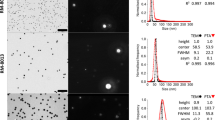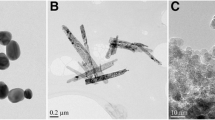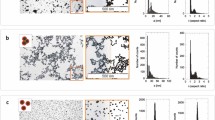Abstract
Transmission electron microscopy (TEM) in combination with a systematic selection procedure for unbiased random image collection, semi-automatic image analysis, and data processing has been validated for size, shape, and surface topology measurements of silica nanoparticles. The validation study, assessing the precision and accuracy of the TEM method, consists of series of measurements on two colloidal silica-certified reference materials, with number-based modal area-equivalent circular diameters (ECD) of 19.4 nm (ERM-FD100) and 27.8 nm (ERM-FD304). The measurement uncertainties are estimated for the modal and median particle size, shape, and surface topology parameters of single primary particles. The single primary particles are distinguished from agglomerates using a linear discriminant analysis approach. After optimization of the binning process, the mode associated with the number-based particle size distribution is obtained by lognormal fitting. The methodology described in this paper relies on a high level of automation of calibration, image acquisition, image analysis, and data analysis and gives robust results for the modal ECD. The expanded uncertainty of the modal ECD is estimated to be about 3 %. The largest contribution to the expanded uncertainty stems from the uncertainty associated with the trueness of the TEM method.





Similar content being viewed by others
References
ASTM E766-98(2008)e1 (2008) Standard practice for calibrating the magnification of a scanning electron microscope. Am Soc Test Mater 49:439–442. doi:10.1520/E0766-98R08E01
Bau S, Witschger O, Gensdarmes F, Rastoix O, Thomas D (2010) A TEM-based method as an alternative to the BET method for measuring off-line the specific surface area of nanoaerosols. Powder Technol 200(3):190–201. doi:10.1016/j.powtec.2010.02.023
Bonas G, Zervou M, Papaeoannou T, Lees M (2003) SoftCRM: a new software for the certification of reference materials. Accred Qual Assur 8(3):101–107. doi:10.1007/s00769-003-0597-9
Braun A, Couteau O, Franks K, Kestens V, Roebben G, Lamberty A, Linsinger TPJ (2011a) Validation of dynamic light scattering and centrifugal liquid sedimentation methods for nanoparticle characterisation. Adv Powder Technol 22(6):766–770. doi:10.1016/j.apt.2010.11.001
Braun A, Franks K, Kestens V, Roebben G, Lamberty A, Linsinger TPJ (2011b) Certified reference material ERM®-FD100: certification of equivalent spherical diameters of silica nanoparticles in water. In: Couteau O (ed) Report EUR 25018 EN. European Union, Luxembourg. doi:10.2787/33725
De Temmerman P-J, Van Doren E, Verleysen E, der Van Stede Y, Francisco M, Mast J (2012) Quantitative characterization of agglomerates and aggregates of pyrogenic and precipitated amorphous silica nanomaterials by transmission electron microscopy. J Nanobiotechnol 10(24):10–24. doi:10.1186/1477-3155-10-24
EC (2011) Commision recommendation of 18 October 2011 on the definition of nanomaterial. Off J Eur Un 275:38–40
EFSA (2011) Scientific opinion: guidance on the risk assessment of the application of nanoscience and nanotechnologies in the food and feed chain. EFSA J 9(5):2140. doi:10.2903/j.efsa.2011.2140
Ehara K, Sakurai H (2010) Metrology of airborne and liquid-borne nanoparticles: current status and future needs. Metrologia 47(2):83. doi:10.1088/0026-1394/47/2/S09
FEI (2012) Tecnai on-line help manual—options. http://www4.utsouthwestern.edu/mcif/manuals/tecnai/Options.pdf
Franks K, Braun A, Charoud-Got J, Couteau O, Kestens V, Lamberty A, Linsinger TPJ, Roebben G (2012) Certified reference material ERM®-FD304: certification of the equivalent spherical diameters of silica nanoparticles in aqueous solution. In: Rasmussen K (ed) EUR 24620 EN. European Union, Luxembourg. doi:10.2787/53476
Freedman D, Diaconis P (1981) On the histogram as a density estimator: L 2 theory. Z Wahrscheinlichkeit 57(4):453–476. doi:10.1007/bf01025868
IRMM (2011) Certificate of analysis ERM®-FD100. Institute for Reference Materials and Measurements, Geel
IRMM (2012) Certificate of analysis ERM®-FD304. Institute for Reference Materials and Measurements, Geel
ISO 13322-1 (2004) Particle size analysis - image analysis methods. Part 1: static image analysis methods. International Organization for Standardization, Geneva
ISO 9276-1 (1998) Representation of results of particle size analysis. Part 1: graphical representation. International Organization for Standardization, Geneva
ISO 9276-2 (2001) Representation of results of particle size analysis. Part 2: calculation of average particle sizes/diameters and moments from particle size distributions. International Organization for Standardization, Geneva
ISO 9276-3 (2008) Representation of results of particle size analysis. Part 3: adjustment of an experimental curve to a reference model. International Organization for Standardization, Geneva
ISO 9276-6 (2008) Part 6: descriptive and quantitative representation of particle shape and morphology. Representation of results of particle size analysis. International Organization for Standardization, Geneva
ISO/IEC GUIDE 98-3 (2008) Uncertainty of measurement. Part 3: guide to the expression of uncertainty in measurement (gum:1995). International Organization for Standardization, Geneva
ISO/TS 27687 (2008) Nanotechnologies—terminology and definitions for nano-objects—nanoparticle, nanofibre and nanoplate. International Organization for Standardization, Geneva
Kaiser DL, Watters RL (2007) Reference material 8012: gold nanoparticles, nominal 30 nm diameter. Report of Investigation. National Institute of Standards & Technology, Gaitersburg
Klein C, Comero S, Stahlmecke B, Romazanov J, Kuhlbusch T, Van Doren E, De Temmerman P-J, Mast J, Wick P, Krug H, Locoro G, Hund-Rinke K, Kördel W, Friedrichs S, Maier G, Werner J, Linsinger TPJ, Gawlik BM (2011) NM-Series of Representative Manufactured Nanomaterials: NM-300 Silver Characterisation, Stability, Homogeneity. EUR 24693 EN—2011. doi:10.2788/23079
Linsinger TPJ (2010) ERM Application Note 1. Comparison of a measurement result with the certified value. European Commission - Joint Research Centre Institution for Reference Materials and Measurements (IRMM), Geel
Linsinger TPJ, Roebben G, Gilliland D, Calzolai L, Rossi F, Gibson N, Klein C (2012) Requirements on measurements for the implementation of the European Commission definition of the term ‘nanomaterial’. EUR 25404 EN, Martinsburg. doi:10.2787/63490
Mast J, Demeestere L (2009) Electron tomography of negatively stained complex viruses: application in their diagnosis. Diagn Pathol 4:5. doi:10.1186/1746-1596-4-5
Masuda H, Gotoh K (1999) Study on the sample size required for the estimation of mean particle diameter. Adv Powder Technology 10(2):159–173. doi:10.1163/156855299x00055
Merkus HG (2009) Particle size measurements: fundamentals, practice, quality. Springer, Pijnacker. doi:10.1007/978-1-4020-9016-5
OECD (2010) Guidance manual for the testing of manufactured nanomaterials: OECD sponsorship programme: first revision ENV/JM/MONO(2009) 20/REV. Organisation for Economic Co-operation and Development, Paris
Pons MN, Vivier H, Belaroui K, Bernard-Michel B, Cordier F, Oulhana D, Dodds JA (1999) Particle morphology: from visualisation to measurement. Powder Technol 103(1):44–57. doi:10.1016/s0032-5910(99)00023-6
Pyrz WD, Buttrey DJ (2008) Particle size determination using TEM: a discussion of image acquisition and analysis for the novice microscopist. Langmuir 24(20):11350–11360. doi:10.1021/la801367j
Roebben G, Rasmussen K, Kestens V, Linsinger TPJ, Rauscher H, Emons H, Stamm H (2013) Reference materials and representative test materials: the nanotechnology case. J Nanopart Res 15(3):1–13. doi:10.1007/s11051-013-1455-2
Russ JC (2011) The image processing handbook. CRC Press, Boca Raton. doi:10.1017/S1431927611012050
SCENIHR (2010) Scientific basis for the definition of the term “Nanomaterial”. scenihr_o_032. Scientific committee on emerging and newly identified health risks, Brussels. doi:10.2772/39703
Scott DW (2009) Sturges’ rule. WIRes Comp Stat 1:303–306. doi:10.1002/wics.35
Scott DW (2010) Scott’s rule. WIRes Comp Stat 2:497–502. doi:10.1002/wics.103
Van Doren E, De Temmerman P-J, Francisco M, Mast J (2011) Determination of the volume-specific surface area by using transmission electron tomography for characterization and definition of nanomaterials. J Nanobiotechnol 9(1):17. doi:10.1186/1477-3155-9-17
Wojdyr M (2010) Fityk: a general-purpose peak fitting program. J Appl Cryst 43:1126–1128. doi:10.1107/S0021889810030499
Acknowledgments
Thomas Linsinger (IRMM) is acknowledged for his expert advice on the evaluation of the uncertainty contribution from the trueness assessment. Elke Van Doren, Nadine Dubois, Marina Ledecq, and Michel Abi Daoud Francisco (CODA-CERVA) are acknowledged for their expert technical assistance. The research leading to these results has been supported by the Nanokara Project of CODA-CERVA and has been partially funded by the European Union Seventh Framework Programme (FP7/2007–2013) under the Project NANoREG (A Common European Approach to the regulatory testing of nanomaterials), grant agreement 310584.
Conflict of interest
The author(s) declare that they have no competing interests.
Author information
Authors and Affiliations
Corresponding author
Appendices
Appendix 1
See Fig. 6.
Appendix 2
See Table 6.
Appendix 3
See Table 7.
Appendix 4
See Table 8.
Appendix 5
See Fig. 7.
Comparison of sphericity-based separation of single primary particles and agglomerated primary particles of samples ERM-FD100 and ERM-FD304 at magnifications of 18,500 and 68,000 times. The number-based sphericity distributions of ERM-FD100 and ERM-FD304 at magnifications of 18,500 times (filled circle) and 68,000 times (unfilled circle) are given in (a) and (c), respectively. The separation threshold, which separates the primary particles and agglomerates, is set to 0.4 for ERM-FD100 and to 0.5 for ERM-FD304. This threshold is indicated by a black arrow in (a) and (c). Micrographs (b) and (d) are recorded at a magnification of 68,000 times and illustrate the separation method. Particles in green are primary particles with a sphericity higher than 0.4 for ERM-FD100 (c) and higher than 0.5 for ERM-FD304 (d). Particles with a sphericity lower than these respective thresholds are colored red. Blue circles indicate the misclassified particles. Scale bar corresponds to 200 nm. (Color figure online)
Appendix 6
See Fig. 8.
Number-based size distributions of ERM-FD100 (a) and ERM-FD304 (b) at magnification of 68,000 times. The reported fittings are based on the mean values of the mode and FWHM in Appendix 7
Appendix 7
See Table 9.
Appendix 8
See Table 10.
Appendix 9
See Table 11.
Appendix 10
See Fig. 9.
Relative uncertainties (%) for ERM-FD100 at magnification of 18,500 (a) and 68,000 times (b) and for ERM-FD304 magnification of 18,500 (c) and 68,000 times (d). For 23 median measured measurands, the repeatability uncertainty is indicated in blue; the intermediate precision uncertainty is indicated in red and intra-laboratory uncertainty is indicated in green. (Color figure online)
Rights and permissions
About this article
Cite this article
De Temmerman, PJ., Lammertyn, J., De Ketelaere, B. et al. Measurement uncertainties of size, shape, and surface measurements using transmission electron microscopy of near-monodisperse, near-spherical nanoparticles. J Nanopart Res 16, 2177 (2014). https://doi.org/10.1007/s11051-013-2177-1
Received:
Accepted:
Published:
DOI: https://doi.org/10.1007/s11051-013-2177-1








